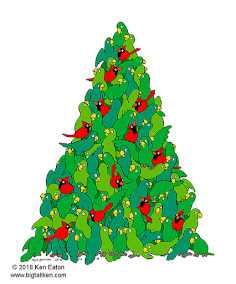He has always enjoyed drawing and comics. After (re) discovering Edward Gorey, he found himself inspired by the myriad ways words and pictures can be assembled in book form to create humor, mystery, suspense, drama, and delightful nonsense.
Hi Ken, we are excited to get to know you a little better. What are some of your go-to inspirations when drawing?
Thank you! It's exciting to contribute to The Mitten!
If I need inspiration, I have a large collection of picture books (mostly vintage), like Dr. Seuss, Arnold Lobel, Jose Aruego and Ariane Dewey, Tomi Ungerer, Richard Scarry, Edward Gorey, and many others.
The reference books I go to most are by Jack Hamm. I’ve had his Cartooning the Head and Figure since the third grade and still reference it. The others I reference are How to Draw Animals, Drawing the Head and Figure, and Drawing Scenery: Landscapes and Seascapes.
I also keep a sketchbook with me to jot down ideas, doodle, or sketch something that catches my eye.
Tell us a little about your process and tools.
My traditional drawing tools are primarily pencil and ink applied with a dip pen or brush. For sketching, I really like the Pentel color brush and Stylo pen. I generally rely on watercolors and colored pencil for traditional coloring. The paper I use depends on the drawing medium. If I am only going to scan in pencil work, I may use regular sketch paper; but for ink and watercolor, I’ll use Bristol board or 100% cotton watercolor paper.
For making book dummies, I started with Adobe InDesign, but I have switched to Microsoft PowerPoint. It gets the job done and is much more user-friendly.
I have been documenting some of these processes on my blog if you would like more detail.
Do you have a dedicated workspace? Do you prefer quiet, or do you listen to podcasts or music when you work?
Yes, I am fortunate to have a big and bright basement office area. Although our house was built in 1925, the ceilings are tall enough to accommodate my 6’7" height. It holds my large drafting table, vintage taboret, much needed file cabinets, and a closet full of my art supplies.What aspects of your work offer hints about who you are? Are there underlying themes you hope people pick up on?
I strive to make my characters feel alive, engaging and choose an art style that fits the story. I would say the general themes are a balance of humor, friendship, learning, and sharing knowledge, which are also things that have helped me get through life.
It’s fascinating that you are both an engineer and an artist. Tell us something more about you that people might not know.
Yes, my full-time job is an engineer at an automotive supplier. Because I was pretty good with math and science, I was encouraged (except by my high school art teacher) to go into engineering and pursue art on the side, and that’s what I’ve done ever since.
The steady income from my engineering job has provided opportunities for travel, cooking classes, and art classes, which is how I met my partner.
I have learned that my art and engineering work complement each other. My art skills have helped me work through technical issues, explain technical information to others, and with making pretty presentations, while engineering has helped me with writing, people skills, and problem solving.
Thanks for sharing with us, Ken!
Be sure to check out bigtallken.com and Instagram for more.








Ken, I love your banner and all the Michigan related things to find in it (even in the trees)!
ReplyDeleteKen, what a fun interview and I love your banner! I use PowerPoint too for my picture book dummies. I'm not an illustrator but I find it very easy to see the pacing of my story.
ReplyDeleteLove this, Ken!! Your work is really great and it's nice to get to know you a bit better.
ReplyDeleteHi, Ken. Great banner! Thanks for the interesting interview.
ReplyDeleteWow, as a wannabe illustrator, I appreciate hearing more about your tools and process. Thanks so much for sharing the info and best wishes to you for all your future projects.
ReplyDeleteGreat Banner! I thoroughly enjoyed your blog about your process, and the tip of using Power Point as an easier version than Adobe Illustrator and InDesign. Best to you in your future.
ReplyDeleteWonderful interview, Ken! I love reading about the processes and inspiration behind the creativity of our members! Thank you for sharing your great banner too!
ReplyDeleteLove the banner, Ken! Your work is fantastic!
ReplyDeleteThanks for the banner. So fun!
ReplyDeleteThank you for your positive comments and to Sarah and Darren for the opportunity to create a banner and the interview. I'm glad the process posts are helpful, since that's is how I learned things myself over the years.
ReplyDeleteSCBWI or Bust. I love it. Especially the animals that are coming to town. Nice interview too.
ReplyDelete